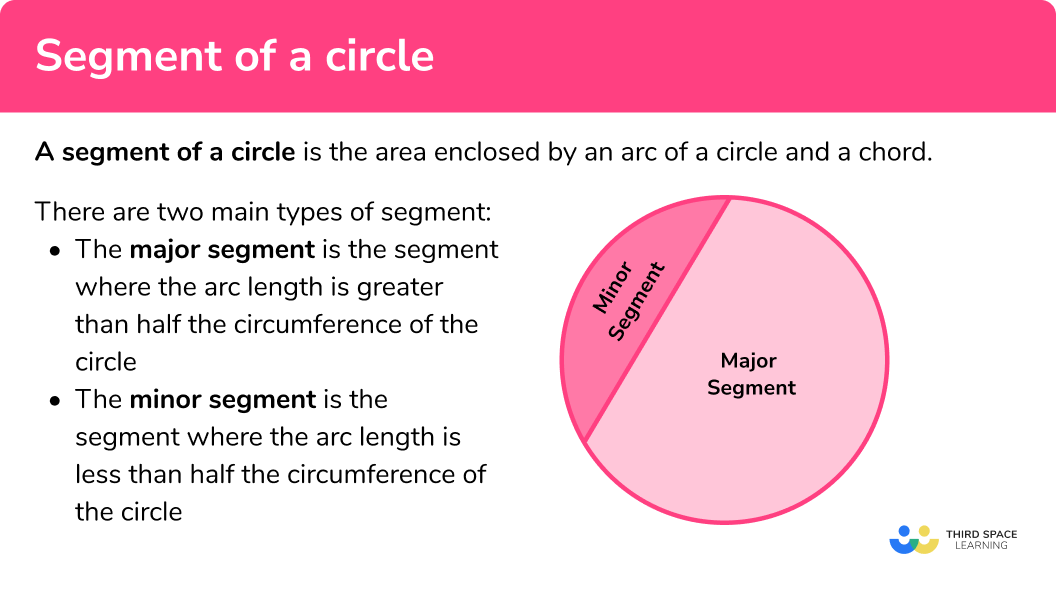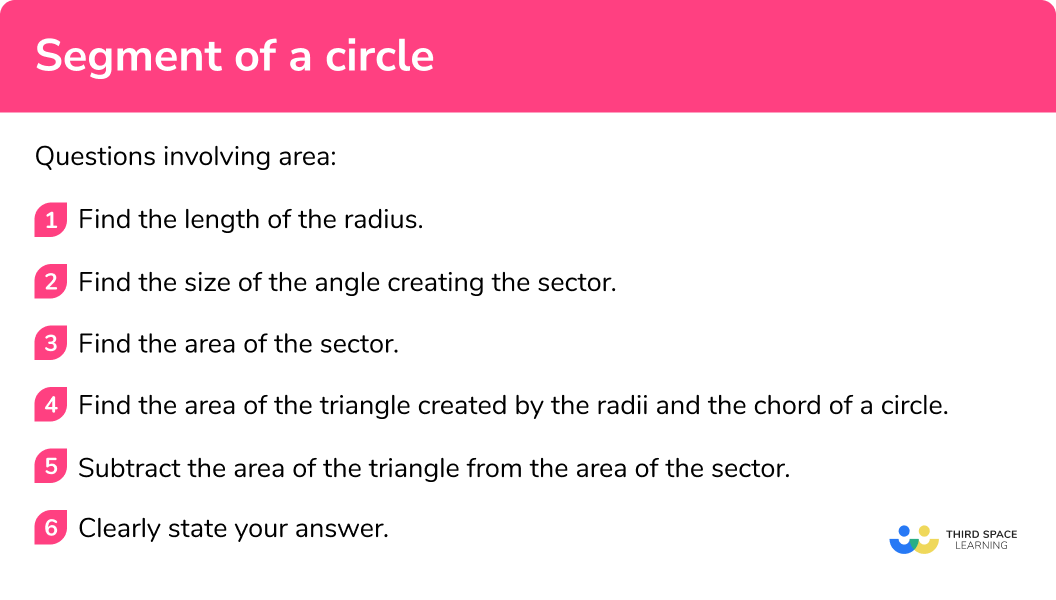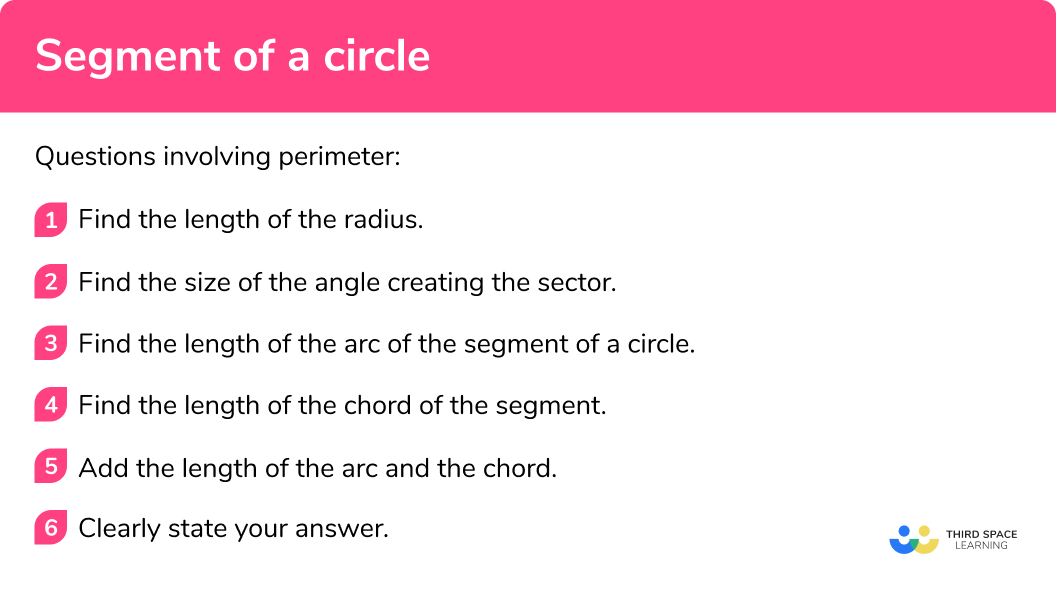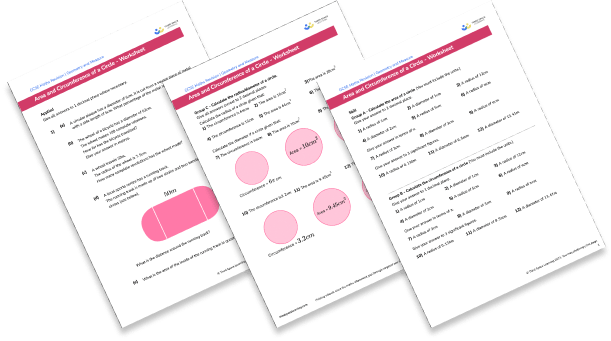GCSE Tutoring Programme
Our chosen students improved 1.19 of a grade on average - 0.45 more than those who didn't have the tutoring.
In order to access this I need to be confident with:
Parts of a circle Area of a sector Area of a triangle Arc length Pythagoras’ theorem Cosine rule Area of a triangle (1/2 abSinC) RoundingThis topic is relevant for:

Segment Of A Circle
Here we will learn about the segment of a circle including how to identify the segment of a circle and how to find the area of a segment given the different parts of a circle.
There are also parts of a circle worksheets based on Edexcel, AQA and OCR exam questions, along with further guidance on where to go next if you’re still stuck.
What is the segment of a circle?
A segment of a circle is the area enclosed by an arc of a circle and a chord.
There are two main types of segment:
- The major segment is the segment where the arc length is greater than half the circumference of the circle
- The minor segment is the segment where the arc length is less than half the circumference of the circle
An arc is a fraction of the circumference of a circle.
A chord is a line segment that connects two points of a circle.
A segment where the chord passes through the centre of the circle is called a semicircle.
What is the segment of a circle?

How to solve problems involving a segment of a circle
In order to solve problems involving a segment of a circle:
Questions involving area
- Find the length of the radius.
- Find the size of the angle creating the sector.
- Find the area of the sector.
- Find the area of the triangle created by the radii and the chord of a circle.
- Subtract the area of the triangle from the area of the sector.
- Clearly state your answer.
How to solve problems involving a segment of a circle (area)

Questions involving perimeter
- Find the length of the radius.
- Find the size of the angle creating the sector.
- Find the length of the arc of the segment of a circle.
- Find the length of the chord of the segment.
- Add the length of the arc and the chord.
- Clearly state your answer.
How to solve problems involving a segment of a circle (perimeter)


Segment and other parts of a circle worksheet

Get your free parts of a circle worksheet of 20+ questions and answers on all parts of circles including segments. With reasoning and applied questions.
DOWNLOAD FREE
Segment and other parts of a circle worksheet

Get your free parts of a circle worksheet of 20+ questions and answers on all parts of circles including segments. With reasoning and applied questions.
DOWNLOAD FREERelated lessons on circles, sectors and arcs
Segment of a circle is part of our series of lessons to support revision on circles, sectors and arcs. You may find it helpful to start with the main circles, sectors and arcs lesson for a summary of what to expect, or use the step by step guides below for further detail on individual topics. Other lessons in this series include:
Segment of a circle examples
Example 1: calculate the area of a segment of a circle
Calculate the area of the segment shown below. Give your answer to 3 significant figures
- Find the length of the radius.
Length of the radius of the circle: 7cm
2Find the size of the angle creating the sector.
The size of the angle creating the sector (made by the two radii) is 90^{\circ} .
3Find the area of the sector.
Area of sector: \frac{49}{4} \pi \mathrm{cm}^{2}
It is important to not round the answer at this stage of the question
4Find the area of the triangle created by the radii and the chord.
Area of triangle: 24.5cm^{2}
5Subtract the area of the triangle from the area of the sector.
6Clearly state your answer.
The question asked you to round your answer to 3 significant figures
Area of the segment of the circle= 13.9845...cm^{2}=14.0cm^{2} ( 3 .s.f.)
Example 2: calculate the perimeter of a segment
Calculate the perimeter of the segment shown below. Give your answer to 3 decimal places
Find the length of the radius.
Length of radius: 7cm
Find the size of the angle creating the sector.
The size of the angle creating the sector (made by the two radii) is 90^{\circ}
Find the length of the arc of the segment.
Length of the arc: \frac{7}{2} \pi cm
Find the length of the chord of the segment.
In this question you can see the two radii and the chord form a right angled triangle. This means you can use Pythagoras’ theorem to find the length of the chord, which is the hypotenuse of the triangle.
Therefore the length of the chord is 7 \sqrt{2} \mathrm{cm}
Add the length of the arc and the chord.
Clearly state your answer.
The question asked you to round your answer to 3 decimal places
Perimeter of segment: 20.895069…cm= 20.895cm (3.d.p)
Example 3: calculate the area of a segment given the length of the radii and the angle
Calculate the area of the segment shown below. Give your answer to 3 decimal places
Find the length of the radius.
Length of radius: 5cm
Find the size of the angle creating the sector.
The size of the angle creating the sector (made by the two radii) is 100^{\circ} . This is given in the question.
Find the area of the sector.
Area of sector: \frac{125}{18} \pi \mathrm{cm}^{2}
Find the area of the triangle created by the radii and the chord.
Area of triangle: 12.3100…cm^{2}
Subtract the area of the triangle from the area of the sector.
Clearly state your answer.
The question asked you to round your answer to 3 decimal places
Area of segment: 9.50661565...cm^{2}= 9.507cm^{2} (3.d.p)
Example 4: calculate the perimeter of a segment given the length of the radii and the angle
Calculate the perimeter of the segment shown below. Give your answer to 3 decimal places.
Find the length of the radius.
Length of radius: 9cm
Find the size of the angle creating the sector.
Size of angle: 80^{\circ}
Find the length of the arc of the segment of a circle.
Length of the arc: 4 \pi cm
Find the length of the chord of the segment.
In this question, the triangle is not a right angled triangle so we cannot use Pythagoras’ Theorem to find the missing length. Instead we can use the cosine rule.
Length of chord:
Add the length of the arc and the chord.
Clearly state your answer.
The question asked you to round the answer to 3 decimal places.
Perimeter = 24.137cm
Example 5: calculate the area of a segment without the angle of the segment being given
Calculate the area of the segment shown below. Give your answer to 1 decimal place
Find the length of the radius.
Length of radius: 20cm
Find the size of the angle creating the sector.
The angle of the sector, created by the two radii, is not given to you in this question. Here you can use the triangle created by the two radii and the chord to find the angle
You need to apply the cosine rule to find the size of the angle.
A is the angle you are trying to find. You can therefore use the rearranged cosine rule to find the angle.
The size of the angle creating the sector (made by the two radii) is 88.854^{\circ} .
Find the area of the sector.
Area of sector: 310.15897cm^{2}
Find the area of the triangle created by the radii and the chord.
Area of triangle: 199.95999…cm^{2}
Subtract the area of the triangle from the area of the sector.
Clearly state your answer.
The question asked you to round your answer to 1 decimal place
Area of segment: 110.19897cm^{2}= 110.2cm^{2} (1.d.p)
Example 6: calculate the perimeter of a segment without the angle of the segment being given
Calculate the perimeter of the segment shown below. Give your answer to 1 decimal place
Find the length of the radius.
Length of radius: 20cm (given to you in the question)
Find the size of the angle creating the sector.
The angle of the sector, created by the two radii, is not given to you in this question. Here you can use the triangle created by the two radii and the chord to find the angle
You need to apply the cosine rule to find the size of the angle.
A is the angle you are trying to find. You can therefore use the rearranged cosine rule to find the angle.
The size of the angle creating the sector (made by the two radii) is 88.854^{\circ} .
Find the length of the arc of the segment.
Length of arc: 31.0159cm
Find the length of the chord of the segment.
Length of chord: 28cm
Add the length of the arc and the chord.
Length of the arc + Length of chord = 31.0159.. + 28 = 59.0159cm
Clearly state your answer.
The question asked you to round your answer to 1 decimal place
Perimeter of segment: 59.0159...cm = 59.0 cm (1.d.p)
Common misconceptions
- Confusing the segment/sector
A segment is the area enclosed by the arc of a circle and a chord. A sector is the area enclosed by the arc of a circle and two radii.
- Confusing the chord/diameter
A chord can cross a circle at any point, but a diameter but go through the centre of the circle.
- Incorrect use of the cosine rule
Many mistakes are made when applying other rules within a segment question e.g the cosine rule. Take your time with these parts and regularly check that your answer makes sense within the context of the question.
- Not including the chord length when finding the perimeter of a segment
Remember the perimeter of a shape is the sum of the lengths of each of the sides. Therefore the perimeter of a segment is made up the arc and the chord
- Degrees and radians
Angles can be measured in both degrees and radians, however at GCSE we only use degrees.
Practice segment of a circle questions
1. What is the area of the segment in the diagram? Give your answer to 1 decimal place




\text{Area of triangle }=\frac{1}{2}ab \sin C\\ =\frac{1}{2}\times 12 \times 12 \sin(90)\\ =72
\text{Area of segment }=36 \pi – 72\\ =41.09733553\\ =41.1\mathrm{cm}^{2}
2. What is the perimeter of the segment in the diagram? Give your answer to 1 decimal place




Length of cord:
a^{2}+b^{2}=c^{2} \\ 12^{2}+12^{2}=c^{2} \\ 144+144=c^{2} \\ 288=c^{2} \\ 12 \sqrt{2}=c\text{Length of the arc }+\text{ Length of the chord } = 6\pi + 12 \sqrt{2}\\ =35.82011867\\ =35.8\mathrm{cm}
3. Calculate the area of the segment shown. Give your answer to 1dp .




\text{Area of triangle }=\frac{1}{2}ab \sin C\\ =\frac{1}{2}\times 4 \times 4 \sin(160)\\ =2.73616…
\text{Area of segment }=\frac{64}{9} \pi – 2.73616\\ =19.60405\\ =19.6\mathrm{m}^{2}
4. Calculate the perimeter of the segment shown. Give your answer to 3 significant figures.




Length of cord:
a^{2}=b^{2} + c^{2} -2bc \cos(A)\\ a^{2}=2^{2} + 2^{2} – 2 \times 2 \times 2 \times \cos(55)\\ a^{2}=8-8 \cos(55)\\ a^{2}=3.411388509\\ a=1.846994453\text{Length of the arc }+\text{ Length of the chord } =\frac{11}{18} \pi + 1.846994453\\ =3.76685663
5. Calculate the area of the segment shown. Give your answer to 2 decimal places.




First we need to find the angle using the cosine rule.
\cos{A}=\frac{b^{2}+c^{2}-a^{2}}{2 b c} \\ \cos{A}=\frac{5^{2}+5^{2}-8.5^{2}}{2 \times 5 \times 5} \\ \cos{A}=-\frac{89}{200} \\ A=\cos^{-1}\left(-\frac{89}{200}\right) \\ A=116.4233388^{\circ}\text{Area of sector }=\frac{\theta}{360} \pi r^{2}\\ =\frac{116.423}{360}\times \pi \times 5^{2}\\ =25.39955844
\text{Area of triangle }=\frac{1}{2}ab \sin C\\ =\frac{1}{2}\times 5 \times 5 \sin(116.423)\\ =11.194165
\text{Area of segment }=25.39955844 – 11.194165\\ =14.20539344\\ =14.21\mathrm{cm}^{2}
6. Calculate the perimeter of the segment shown. Give your answer to 3 significant figures.




First we need to find the angle using the cosine rule.
\cos{A}=\frac{b^{2}+c^{2}-a^{2}}{2 b c} \\ \cos{A}=\frac{7^{2}+7^{2}-8^{2}}{2 \times 7 \times 7} \\ \cos{A}=\frac{17}{49} \\ A=\cos^{-1}\left(\frac{17}{49}\right) \\ A=69.69980^{\circ}\text{Arc length}=\frac{\theta}{360} \times 2 \pi r \\ =\frac{69.6998}{360} \times 2 \pi \times 7 \\ =8.515436986
Chord length: 8mm
\text{Perimeter }=8.515436986+8\\ =16.515436986\\ =16.5\mathrm{mm}
Segment of a circle GCSE questions
1. The diagram shows a sector OABC of a circle with centre O .
(a) Calculate the length of the arc ABC of the sector. Give your answer correct to 3 significant figures.
(b) Calculate the area of the shaded segment ABC . Give your answer correct to 3 significant figures.
(7 marks)
(a)
\frac{120}{360} \times \pi \times 20.8(1)
21.781709(1)
21.8 cm(1)
(b)
Either 113.26… or 46.83 seen
(1)
“113.26…” – “46.83”(1)
66.430…(1)
66.4 cm^{2}(1)
2. The diagram shows a sector OPRS of a circle with centre O .
Calculate the area of the shaded segment PRS .
Give your answer correct to 3 significant figures.
(5 marks)
Area of sector = 22.34
(1)
Area of triangle = 20.569
(1)
“22.340…” – “20.569”(1)
=1.7710…(1)
=1.77cm^{2}(1)
3. The diagram shows a sector OPRS of a circle with centre O .
Calculate the area of the shaded segment RST .
Give your answer correct to 3 significant figures.
(5 marks)
Area of sector = 1954.76876…
(1)
Area of triangle = 1835.444…
(1)
“1954.768…” – “1835.444”(1)
119.324…(1)
119cm^{2}(1)
4. The diagram below shows a shaded segment.
(a) Find the area of the shaded segment. Give your answer correct to 3 significant figures.
(b) Find the perimeter of the shaded segment. Give your answer correct to 3 significant figures.
(9 marks)
(a)
Angle at centre = 112.88538 … may be shown on diagram
(1)
Area of sector = 141.85595…
(1)
Area of triangle = 66.332496…
(1)
“141.85595” – “66.332496”(1)
= 75.523454..(1)
75.5cm^{2}(1)
(b)
Length of arc = 23.6426587…
(1)
Length of chord = 20
(1)
“23.6426587” + 20(1)
= 43.6426587(1)
43.6cm(1)
Learning checklist
You have now learned how to:
-
Identify and apply circle definitions and properties
-
Identify and apply circle definitions and properties, including a segment
-
Find the perimeter of a segment
-
Calculate areas of segments by applying trigonometry
The next lessons are
Still stuck?
Prepare your KS4 students for maths GCSEs success with Third Space Learning. Weekly online one to one GCSE maths revision lessons delivered by expert maths tutors.

Find out more about our GCSE maths tuition programme.